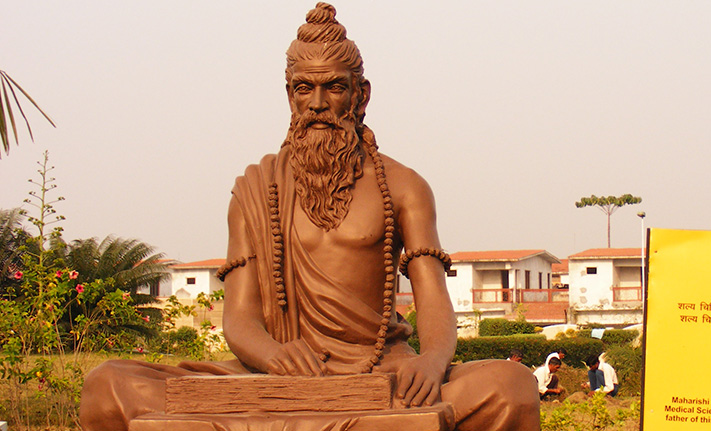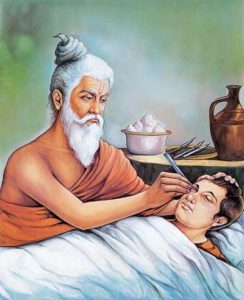 Maharishi Sushruta, one of the earliest surgeons of the recorded history of India. He is believed to be the first individual to perform and document different forms of surgery. Sushruta who lived nearly 150 years before Hippocrates has described in details the basic principles of various methods of surgery in his famous ancient treatise ‘Sushruta Samhita’.
Maharishi Sushruta, one of the earliest surgeons of the recorded history of India. He is believed to be the first individual to perform and document different forms of surgery. Sushruta who lived nearly 150 years before Hippocrates has described in details the basic principles of various methods of surgery in his famous ancient treatise ‘Sushruta Samhita’.
‘Sushruta Samhita'(Sushruta’s compendium), which describes the ancient tradition of surgery in Indian medicine is considered as one of the most brilliant works in Indian medical literature. This treatise contains detailed descriptions of teachings and practice of the great ancient surgeon Sushruta which has considerable surgical knowledge of relevance even today.
Susruta is understood to be the son of Visvamitra , as documented in the Susrutasamhita. Sustruta was sent to study Ayurveda with special emphasis on Salya (surgery) under Divodasa Kasi Raja Dhanvantari of the Upanishadic age.
Maharishi Sushruta
Nagarjuna’s Upayahrdaya refers to Susruta and this takes him definitely to a period before Nagarujna who is believed to have lived about 2000 years ago. Further, Susruta has been mentioned both in Mahabhashya of Patanjali and the Varttika of Katyayana. It seems that the descendants of Susruta were earlier than Panini, the great grammarian. Although the grammatical works do not mention Susruta to be the promulgator of Salyatantra, all the grammarians quote him as the famous teacher and originator of a specialised branch of learning, and the followers were known after him as Sausrutas. No other teacher in the name of Susruta is known except the medical writer who was the propagator of Salyantantra. Hence, Susruta is believed to be older than Panini, though there are others who push his antiquity back to 3000BC, which does not seem tenable.
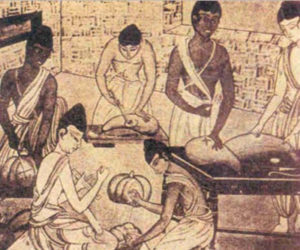 Sushruta lived, taught and practiced his art in the area that corresponds presently to the city of Varanasi (Kashi, Benares) in northern part of India. Varanasi, on the banks of the Ganges is one of the holiest places in India and is also the home of Buddhism and Ayurveda, one of the oldest medical disciplines. The followers of Sushruta were called as Saushrutas. The new student was expected to study for at least 6 years. Before starting his training he had to take a solemn oath, which can be compared to that of Hippocrates. He taught the surgical skills to his students on various experimental modules, for instance, incision on vegetables (like watermelon, gourd, cucumber etc.), probing on worm eaten wood, preceding present day workshops by more than 2600 years.
Sushruta lived, taught and practiced his art in the area that corresponds presently to the city of Varanasi (Kashi, Benares) in northern part of India. Varanasi, on the banks of the Ganges is one of the holiest places in India and is also the home of Buddhism and Ayurveda, one of the oldest medical disciplines. The followers of Sushruta were called as Saushrutas. The new student was expected to study for at least 6 years. Before starting his training he had to take a solemn oath, which can be compared to that of Hippocrates. He taught the surgical skills to his students on various experimental modules, for instance, incision on vegetables (like watermelon, gourd, cucumber etc.), probing on worm eaten wood, preceding present day workshops by more than 2600 years.
Sushruta Samhita
The Susrutasamhita is in two parts, the Purva-tantra in five sections and the Uttara-tantra. Those two parts together encompass, apart from Salya and Salakya, the other specialities also like medicine, pediatrics, geriatrics, diseases of the ear, nose, throat and eye, toxicology, aphrodisiacs and psychiatry. Thus the whole Samhita, devoted as it is to the science of surgery, does not fail to include the salient portions of other disciplines too.
In fact, Susruta emphasises in his text that unless one possesses enough knowledge of relevant sister branches of learning, one cannot attain proficiency in one’s own subject of study. The Samhita is thus an encyclopaedia of medical learning with special emphasis on Salya and Salakya. Sutra-sthana, Nidana-sthana, Sarira-sthana, Kalpa-sthana and Cikitsa-sthana are the five books of the Purvatantra containing one hundred and twenty chapters.
Incidentally, the Agnivesatantra known better as the Charaksamhita and the Astangahrdaya of Vagbhata also contain one hundred and twenty chapters in all.
The Nidana-sthana gives the student the knowledge of aetiology, signs and symptoms of important surgical diseases and those ailments, which have a bearing on surgery.
The rudiments of embryology and anatomy of human body along with instructions for venesection (cutting of veins), the positioning of the patient for each vein, and protection of vital structures (marma) are dealt with in the Sarira-sthana.This also includes the essentials of obstetrics.
Principles of management of surgical conditions including obstetrical emergencies are contained in the Cikitsa-sthana, which also includes a few chapters on geriatrics and aphrodisiacs.
The Kalpa-sthana is mainly Visa-tantra, dealing with the nature of poisons and their management. Thus the Purva-tantra embraces four branches of Ayurveda.
The Uttara-tantra, contains the remaining four specialities, namely, Salakya, Kaumarabhrtya, Kayacikitsa and Bhutavidya.
The entire Uttara-tantra has been called Aupadravika since many of the complications of surgical procedures like fever, dysentery, cough, hiccough, krmi-roga, pandu, kamala, etc., are briefly described here. The Salakya-tantra portion of the Uttara-tantra contains various diseases of the eye, the ear, the nose and the head. Thus the whole Samhita is one comprehensive treatise on the entire medical discipline.
As war was a major cause of injury, the name Salya–tantra is derived from this branch of medical learning. The ancient surgical science was known as Salya-tantra. Salya-tantra (surgical science) embraces all processes aiming at the removal of factors responsible for producing pain or misery to the body or mind. Salya, denotes broken parts of an arrow /other sharp weapons while tantra denotes maneuver. The broken parts of the arrows or similar pointed weapons were regarded as the commonest and most dangerous objects causing wounds and requiring surgical treatment. Shushruta has described surgery under eight heads Chedya (excision), Lekhya (scarification), Vedhya (puncturing), Esya (exploration), Ahrya (extraction), Vsraya (evacuation) and Sivya (Suturing).9,10
Plastic Surgery
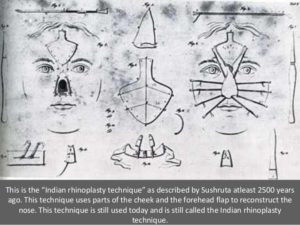 Sushruta has mentioned various methods on plastic surgery including sliding graft, rotation graft and pedicle graft. Nasal repair or rhinoplasty has been described in greater detail, which to this day has stood the test of time and is mentioned as the Indian method of rhinoplasty in the books of plastic surgery. Lastly, labioplasty too has received his attention. In short, all the principles of plastic surgery, viz., accuracy, precision, economy, homeostasis and perfection find an important place in Susruta’s writings on this subject.
Sushruta has mentioned various methods on plastic surgery including sliding graft, rotation graft and pedicle graft. Nasal repair or rhinoplasty has been described in greater detail, which to this day has stood the test of time and is mentioned as the Indian method of rhinoplasty in the books of plastic surgery. Lastly, labioplasty too has received his attention. In short, all the principles of plastic surgery, viz., accuracy, precision, economy, homeostasis and perfection find an important place in Susruta’s writings on this subject.
Tools Used in Ancient Surgery
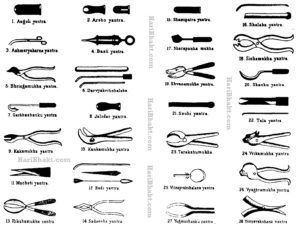 Susruta gives a list of blunt and sharp instruments and adds that a surgeon, by his own experience and intelligence, may invent and add new instruments to facilitate the surgical procedures. He points out that the hand is the most important and the best instrument but for which the operation of other instruments ceases. The blunt instruments are meant for removal of foreign bodies, for sucking the fluids, for facilitating the various surgical procedures and for visualising the lesions.
Susruta gives a list of blunt and sharp instruments and adds that a surgeon, by his own experience and intelligence, may invent and add new instruments to facilitate the surgical procedures. He points out that the hand is the most important and the best instrument but for which the operation of other instruments ceases. The blunt instruments are meant for removal of foreign bodies, for sucking the fluids, for facilitating the various surgical procedures and for visualising the lesions.
He was the pioneer of anesthesia and has promoted the proper use of wine with incense of cannabis for the purpose of inducing anesthesia. The use of henbane and Sammohini and Sanjivani was started in the later period.
Translation into Arabic
This master literature remained preserved for many centuries exclusively in the Sanskrit language which prevented the dissemination. of the knowledge to the west and other parts of the world. Later the original text was lost and the present extant one is believed to be a revision by the Buddhist scholar Vasubandhu (circa AD 360-350). In the eighth century A.D., ‘Sushruta Samhita’ was translated into Arabic as Kitab-Shaw Shoon-a-Hindi and Kitab-i-Susrud. The translation of ‘Sushruta Samhita’ was ordered by the Caliph Mansur (A.D.753 -774).
Source:IF
Image Coutesy:Okar Research
You may also like
-
India Against Mpox
-
Combination of ‘Siddha’ Drugs Reduces Anemia in Adolescent Girls: Study
-
Suspected Mpox Case Under Investigation; Patient Put Under Isolation, No Cause for Alarm
-
Prime Minister Applauds India’s Best Ever Performance at the Paralympic Games
-
National Exit Test (NExT) for Ayush to be Effective from 2021-2022 Batch: Union Minister of Ayush Shri Prataprao Jadhav
